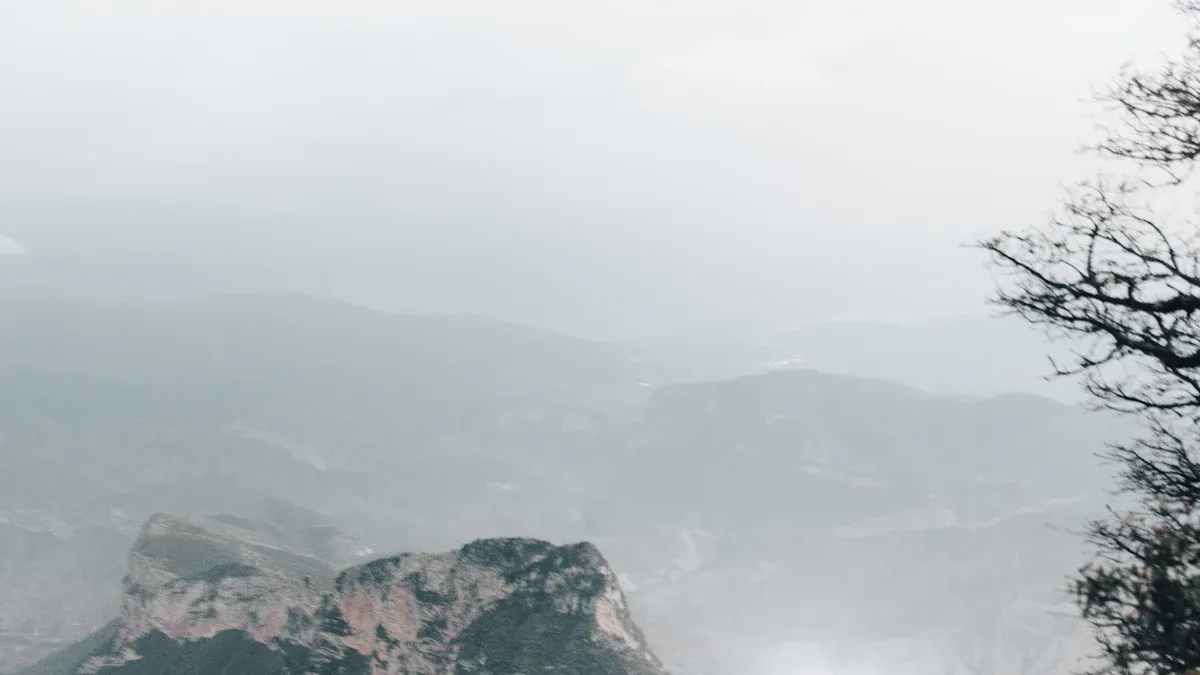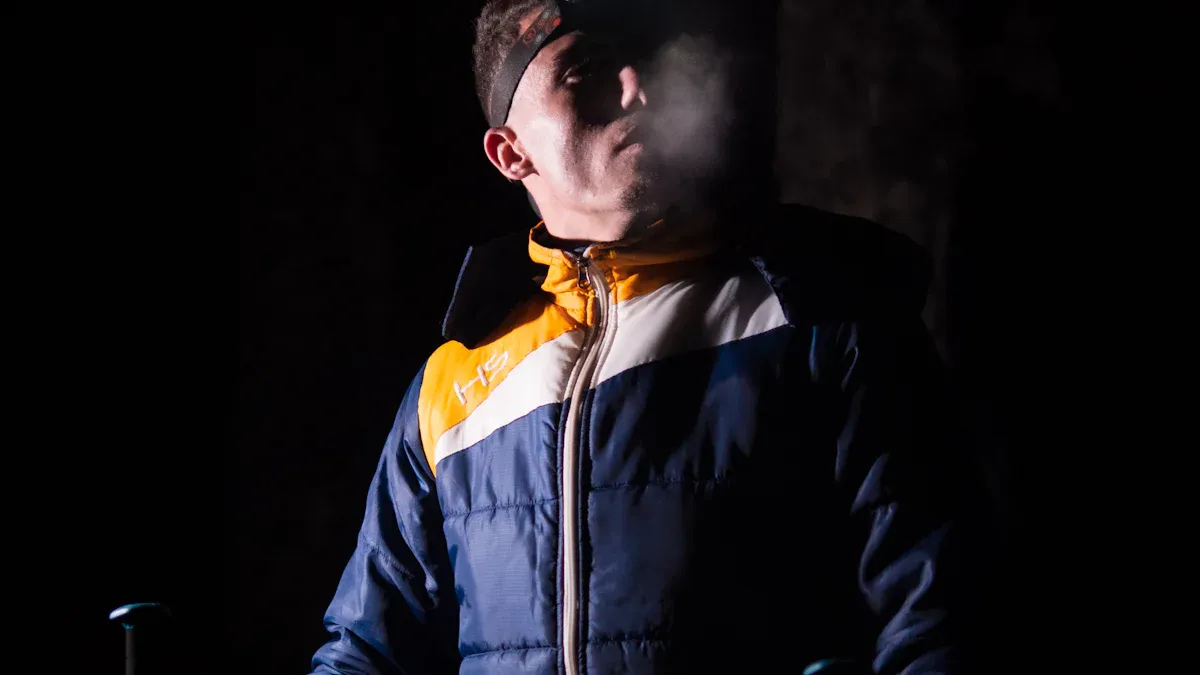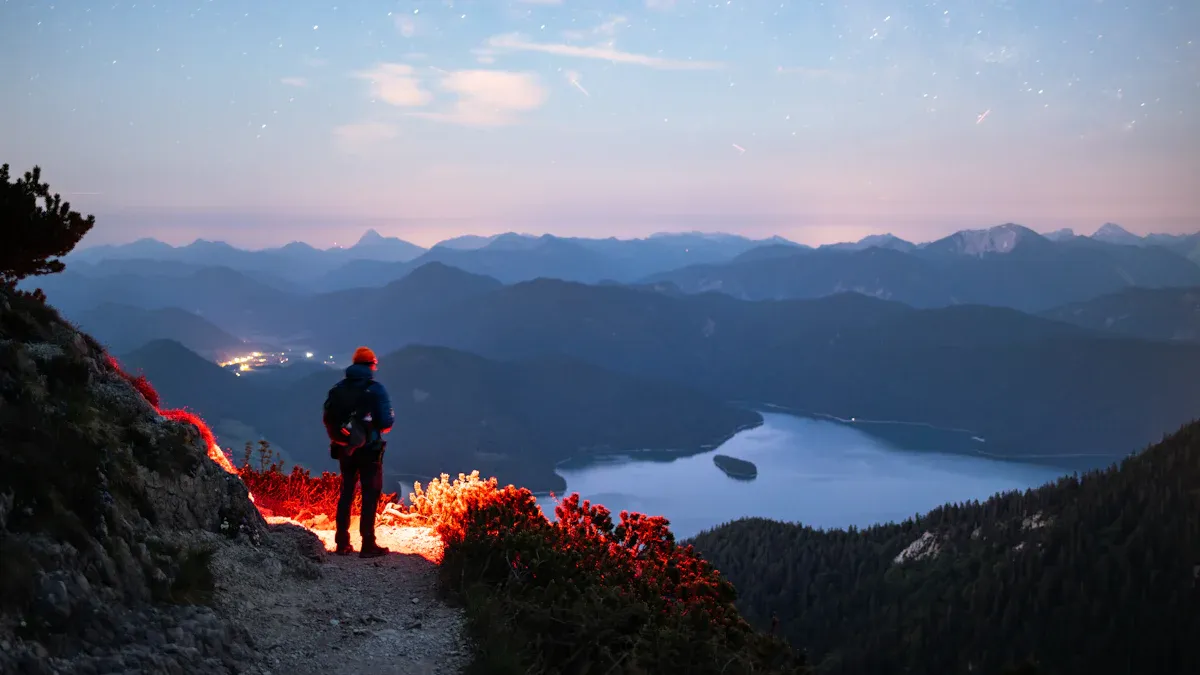Why Every Hiker Needs a Reliable Flashlight

When you’re out on the trail, a flashlight isn’t just a handy gadget—it’s your lifeline. Imagine hiking as the sun sets, and the trail ahead becomes a maze of shadows. A reliable flashlight lights your way, helping you avoid tripping over rocks or roots. It’s also essential for hiking safely in emergencies. For instance, hikers have used flashlights to signal rescuers after getting lost in the dark. This simple tool can even deter wildlife and keep you visible to others. Whether you’re navigating low-light conditions or staying prepared for the unexpected, a flashlight is your best companion for safety and navigation.
Key Takeaways
A good flashlight is important for hiking in dim light. It helps you see clearly and stay on the path in the early morning or late evening.
In emergencies, a flashlight helps you see and call for help. Pick one with an SOS feature to stay safer.
Get a strong and waterproof flashlight for tough outdoor use. This makes sure it works even in bad weather.
Use flashlights with long-lasting batteries, rechargeable or not, for long trips. This way, you won’t be stuck in the dark.
Think about how heavy and easy to carry your flashlight is. Small and light ones are better for hiking without extra weight.
The Role of a Flashlight in Ensuring Safety

Navigating Low-Light Conditions
Avoiding obstacles like rocks, roots, and uneven terrain.
When you're hiking in the dark, even the most familiar trails can become tricky. A flashlight helps you spot hidden roots, jagged rocks, or uneven terrain that could trip you up. Reliable lighting ensures you can walk confidently without worrying about unexpected hazards. Whether you're exploring a dense forest or a rocky path, a flashlight is your best tool to illuminate the path ahead.
Staying on track during early mornings or late evenings.
Starting your hike before sunrise or finishing after sunset? A hiking flashlight keeps you on track. Trails can quickly become confusing in dim light, but a powerful flashlight ensures you can follow trail markers and avoid getting lost. It’s like having a guiding companion that never lets you down.
Emergency Preparedness
Providing light during unexpected weather or injuries.
Emergencies can strike when you least expect them. Sudden storms or injuries can leave you stranded in the dark. A flashlight provides the visibility you need to assess your surroundings and find shelter. It also helps you navigate back to safety, even in total darkness. This is why emergency preparedness always includes a reliable flashlight.
Signaling for help in critical situations.
If you ever find yourself in a dire situation, a flashlight can be a lifesaver. Many models come with strobe or SOS modes, which are perfect for signaling rescuers. For example, you can flash three short bursts, followed by three long ones, to send the universal distress signal. Bright flashlights, especially those exceeding 1500 lumens, are highly effective for attracting attention during search and rescue operations.
Tip: Always carry a flashlight with signaling features. It could make all the difference in an emergency.
Enhancing Visibility
Making hikers visible to others, including vehicles.
Staying visible is crucial, especially if you're hiking near roads or in areas with other hikers. A flashlight not only lights your way but also makes you noticeable to others. This added visibility can prevent accidents and ensure your safety during your outdoor adventures.
Deterring wildlife during nighttime camping or hiking.
Wild animals tend to avoid bright lights. If you're camping or hiking at night, a flashlight can help keep curious wildlife at bay. The beam of a flashlight acts as a deterrent, giving you peace of mind while you enjoy the outdoors.
Key Features of a Reliable Hiking Flashlight
Durability and Water Resistance
Withstanding rugged outdoor conditions.
When you're out hiking, your flashlight needs to handle whatever the outdoors throw at it. From accidental drops on rocky trails to rough handling during long treks, durability is key. Look for flashlights made with tough materials like aluminum or reinforced plastic. These can withstand bumps, falls, and scratches, ensuring they last through your adventures.
Functioning effectively in wet or rainy environments.
Rain or water crossings shouldn’t stop your flashlight from working. Many hiking flashlights come with water resistance ratings, so you know how much moisture they can handle. Here’s a quick guide:
IP Rating | Description |
|---|---|
IPX4 | Great for light rain or brief water exposure, suitable for casual use. |
IPX6 | Withstands temporary submersion, ideal for activities involving water. |
IPX7 | Can handle immersion in water up to 1 meter for 30 minutes. |
IPX8 | Suitable for continuous immersion in water, usually beyond 1 meter. |
Waterproof flashlights maintain consistent brightness even in wet conditions. They’re essential for outdoor enthusiasts who hike in unpredictable weather. Unlike non-waterproof models, these won’t flicker or fail when exposed to moisture.
Battery Life and Power Options
Long-lasting batteries for extended trips.
Battery life can make or break your hiking experience. A flashlight with long-lasting batteries ensures you won’t be left in the dark during extended outdoor trips. Some models can last up to 50 hours on a single charge, depending on the brightness setting. Always check the estimated runtime before heading out.
Rechargeable vs. disposable battery options.
Choosing between rechargeable and disposable batteries depends on your needs. Rechargeable batteries are cost-effective and eco-friendly. They’re perfect for frequent hikers who want to reduce waste. On the other hand, disposable batteries are lightweight and easy to carry, making them ideal for longer trips where charging isn’t an option.
Here’s a quick comparison:
Rechargeable Batteries: Reusable, consistent power, better for the environment.
Disposable Batteries: Convenient, lightweight, and great for emergencies.
Think about your hiking duration and access to power sources when deciding which option works best for you.
Portability and Weight
Compact designs for easy carrying.
A bulky flashlight can weigh you down, especially on long hikes. Compact designs, like keychain or pocket flashlights, are perfect for quick access. They’re small enough to fit in your pocket or attach to your backpack, so you’ll always have light when you need it.
Lightweight options to reduce strain during hikes.
Every ounce counts when you’re hiking. Lightweight flashlights, such as headlamps or mini LED models, reduce strain and free up your hands. For example, the Perun 2 Mini LED headlamp weighs just a few ounces but delivers up to 1,100 lumens of brightness. It’s a great choice for nighttime activities without adding extra weight to your gear.
Tip: Choose a flashlight that balances portability and functionality. You’ll appreciate the convenience on the trail.
Brightness and Beam Distance
Adjustable brightness for various scenarios.
Not all hiking situations need the same level of brightness. That’s why having a flashlight with adjustable brightness is a game-changer. You can dim the light when you’re reading a map or setting up camp to save battery. On the other hand, you can crank up the brightness when you’re navigating a tricky trail or scanning the area for wildlife. Many modern flashlights come with multiple modes, like low, medium, high, and even strobe. These options let you adapt to your surroundings without wasting power.
Tip: Look for flashlights with easy-to-use brightness controls. A simple button or dial can make all the difference when you’re in the dark.
Long beam distance for better visibility in the dark.
When you’re hiking at night, seeing far ahead is crucial. High-quality hiking flashlights often feature adjustable beam distances, which are perfect for different scenarios. A longer beam distance lets you spot obstacles, trail markers, or even wildlife from a safe distance. This added visibility keeps you prepared and helps you make better decisions on the trail.
For example, some flashlights can illuminate up to 200 meters or more. This is especially useful when hiking in open areas or unfamiliar terrain. You’ll feel more confident knowing what’s ahead, whether it’s a sharp turn, a steep drop, or a fork in the trail. A flashlight with a powerful beam ensures you’re not caught off guard by surprises in the dark.
Did you know? Flashlights with a beam distance of over 150 meters are ideal for nighttime hiking. They provide excellent visibility while maintaining a compact design.
Versatility of a Camping Flashlight

Nighttime Activities
Setting up camp or cooking after dark.
When the sun sets, even simple tasks like setting up your tent or preparing a meal can become challenging. A camping flashlight makes these activities much easier. Its bright beam helps you find the right spot for your tent and ensures you don’t miss any tent pegs or cooking tools. A good flashlight with adjustable brightness is perfect for these moments, letting you focus on your tasks without wasting battery power.
Exploring trails or caves at night.
Nighttime adventures like exploring trails or caves can be thrilling, but they require proper lighting. A camping flashlight with a long beam distance helps you see the path ahead clearly, avoiding unexpected obstacles. Whether you’re navigating a rocky trail or discovering hidden cave formations, a reliable flashlight ensures you stay safe and enjoy the experience.
Tip: Always carry extra batteries or a rechargeable flashlight for extended nighttime activities.
Signaling and Communication
Using flashlights to signal other hikers or rescuers.
In emergencies, a flashlight becomes more than just a light source—it’s a communication tool. You can use it to signal your location to rescuers or other hikers. Simply shining the flashlight can attract attention, but using Morse code for SOS (three short flashes, three long flashes, and three short flashes) is even more effective. This universal distress signal is recognized worldwide and could save your life.
Employing flashing patterns or Morse code in emergencies.
Many flashlights come with built-in strobe or SOS modes, making them ideal for emergencies. These flashing patterns are designed to grab attention quickly. Whether you’re lost on a trail or stranded in a remote area, these features ensure you can communicate your need for help effectively.
Did you know? Flashing SOS signals with a flashlight is a practice officially adopted for maritime communication and works just as well on land.
Multi-Functional Flashlights
Flashlights with built-in tools like compasses or whistles.
Some of the best camping flashlights go beyond just providing light. They come equipped with additional tools like compasses, whistles, or even power banks. Brands like Fenix and Olight offer models that combine LED technology with these practical features. These multi-functional flashlights are perfect for outdoor adventures, giving you everything you need in one compact device.
Headlamps for hands-free lighting.
Headlamps are a game-changer for nighttime activities. They’re lightweight, easy to wear, and provide hands-free convenience. Whether you’re setting up camp, cooking, or hiking, a headlamp lets you focus on the task without holding a flashlight. Many models also double as handheld flashlights, offering versatility for various situations.
Pro Tip: Choose a headlamp with adjustable brightness and high comfort for extended use. It’s perfect for staying safe at night while keeping your hands free.
Eco-Friendly and Technological Advancements in Flashlights
Solar-Powered Flashlights
Charging during the day for nighttime use.
Imagine hiking all day and knowing your flashlight is charging itself while you explore. Solar-powered flashlights harness the sun’s energy, making them perfect for outdoor adventures. You don’t need to worry about running out of power because these flashlights store energy during the day for nighttime use. They’re especially handy for multi-day trips where access to electricity is limited.
Reducing reliance on disposable batteries.
By using solar-powered flashlights, you’re not just saving money—you’re helping the planet. These flashlights eliminate the need for disposable batteries, which often end up in landfills. This reduces hazardous waste and lowers your carbon footprint. Plus, they’re reliable in emergency situations, as they don’t depend on traditional power sources.
Aspect | Solar-Powered Flashlights | Traditional Battery-Powered Flashlights |
|---|---|---|
Energy Source | Harness energy from the sun | Depend on disposable batteries or electricity |
Environmental Impact | Minimizes impact from battery disposal | Higher environmental impact due to batteries |
Initial Cost | Higher initial investment | Generally lower initial cost |
Operational Costs | No ongoing costs for batteries | Ongoing costs for disposable batteries |
Reliability | Provides consistent lighting | May vary in reliability based on battery life |
Power Intensity | May not be as powerful in high-intensity use | Typically more powerful in high-intensity use |
Tip: Keep your solar-powered flashlight exposed to sunlight during the day to ensure it’s ready for nighttime use.
LED Technology
Energy-efficient and long-lasting light sources.
LED technology has revolutionized flashlights. LEDs consume less energy than traditional bulbs, which means your flashlight lasts longer on a single charge or set of batteries. This energy efficiency is a game-changer for outdoor enthusiasts who need reliable lighting during extended trips.
Providing brighter and more reliable illumination.
LED flashlights shine brighter than older models, making them ideal for low-light conditions. Whether you’re navigating a dark trail or setting up camp, the bright and consistent light from LEDs ensures you can see clearly. Many LED flashlights also offer adjustable brightness levels, giving you flexibility for different scenarios.
Did you know? LED flashlights can last up to 50,000 hours, making them a durable choice for outdoor adventures.
Sustainable Materials
Flashlights made from recycled or eco-friendly materials.
Some flashlights go beyond functionality by being environmentally friendly. Many are made from recycled plastics, bio-based polymers, or even bamboo-derived components. These materials reduce waste and promote sustainability, making them a great choice for eco-conscious hikers.
Supporting brands committed to environmental sustainability.
Brands like Fenix and Olight are leading the way in producing eco-friendly flashlights. They use sustainable materials and focus on energy-efficient designs. By choosing these brands, you’re supporting companies that prioritize the environment while delivering high-quality products.
Pro Tip: Look for flashlights with Type-C charging compatibility. It’s convenient and reduces the need for multiple cables.
A reliable flashlight is more than just a tool—it’s your safety net on the trail. Whether you’re navigating rocky paths, signaling for help, or deterring wildlife, it’s an essential part of your hiking gear. Look for key features like durability, long battery life, and portability to ensure it meets your outdoor needs. For example:
Choose a flashlight with at least 200 lumens for clear visibility.
Opt for rechargeable batteries to save costs and reduce waste.
Pick a weather-resistant model to handle unpredictable conditions.
With advancements like solar charging and LED technology, today’s flashlights are more efficient and eco-friendly than ever. So, don’t forget to pack one for your next adventure—it could make all the difference.
Pro Tip: A flashlight with multiple lighting modes, like SOS or dimmable brightness, adds versatility to your outdoor experience.
FAQ
1. How many lumens should a hiking flashlight have?
For most hikes, a flashlight with 200-300 lumens works well. If you’re exploring caves or hiking in pitch-black conditions, go for 500 lumens or more. Brightness depends on your activity and environment.
Tip: Higher lumens mean brighter light but can drain the battery faster.
2. Should I choose a headlamp or a handheld flashlight?
It depends on your needs. Headlamps are great for hands-free tasks like setting up camp. Handheld flashlights offer more control and versatility. Many hikers carry both for flexibility.
Pro Tip: A headlamp with adjustable straps and brightness is perfect for long hikes.
3. How do I maintain my flashlight for long-term use?
Keep it clean and dry after every hike. Check the batteries regularly and replace them if needed. For rechargeable models, avoid overcharging. Store your flashlight in a cool, dry place to prevent damage.
4. Are solar-powered flashlights reliable for hiking?
Yes, they’re great for sunny trips. Solar-powered flashlights charge during the day and work well at night. However, they might not perform as effectively in cloudy weather or dense forests.
Note: Always carry a backup flashlight or extra batteries for emergencies.
5. What’s the best way to carry a flashlight while hiking?
Attach it to your backpack or belt for easy access. Compact models fit in your pocket, while headlamps stay secure on your head. Choose a lightweight option to avoid extra strain during your hike.
Did you know? Some flashlights come with clips or straps for added convenience.
See Also
How to Select the Best Rechargeable Flashlight for Hiking
Why Hunting Flashlights Are Crucial for Outdoor Adventures
A Comprehensive Guide to Selecting Flashlights for Backcountry Hiking
